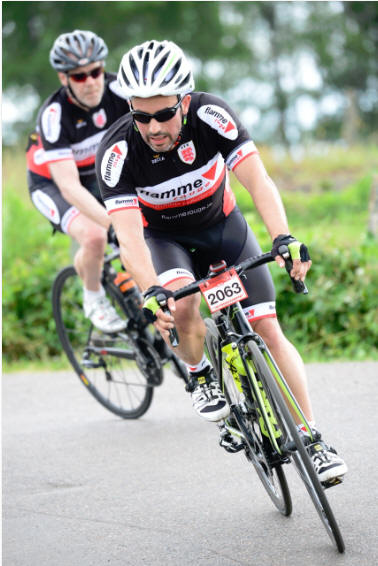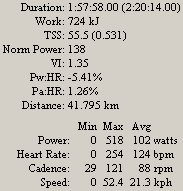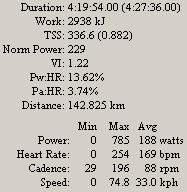Training Load ~ Intensity v Volume
 The
information in this factsheet is complementary to that held
in the VO2max
Development and Threshold Power
factsheets.
The
information in this factsheet is complementary to that held
in the VO2max
Development and Threshold Power
factsheets.
You may wish to read them before or after this factsheet to familiarise yourself with the trilogy of pain, power and success.
Speaking of trilogy's; it also forms a third of the factsheet collection covering the balance of Intensity v Volume, Fitness v Rest and the ever-present spectre of Overtraining.
As you'll see from this Het Volk shot of Philippe Gilbert, if you want to maximise your chances of success, you need to maximise your tolerance to pain. There are two ways to go about that.
Do you do that with training intensity or training volume?
As my all time favourite songsmiths Depeche Mode warbled, amongst other things, "Just hang on; Suffer Well". Which probably gives you a clue to my thoughts on the matter!
The Preamble...
As we've discussed previously (see factsheets mentioned
above), if you are to realise your
true cycling potential (this website's
sole reason for being), you need to make best use of your genetically given
gifts, your VO2max; and increase, through hard work and structured training,
your Functional Threshold Power. Although you have far more influence over one
aspect than the other.
To be a stronger, fitter, faster cyclist you need to understand the options available and choose the ones that work best for you. We are all different and will all react differently to the same stimulus. So don't go undertaking cookie cutter training plans and don't buy a "Train like..." book and follow it slavishly. It probably won't work, well not in the way you're expecting anyway!
Please take the time to read, digest, and reflect on the contents of the three factsheets and mix and match your options to find what sustainably works best for you.
When you've found the magic formula, give it 100% commitment. Just like Philippe Gilbert.
Definitions Just so we all have a common understanding of what we are discussing it's best that we all have the same interpretation of the two main terms we will be covering in this factsheet.
Volume: is the amount of work that we do. It can be measured in hours, miles or whatever you fancy but it has no measure of effort applied to it.
Intensity: is the measure of effort applied during the volume. It can be measured in many ways (heart rate, watts, perceived effort) but has no measure of volume applied to it.
So if someone says I went out and rode for five hours, it may be impressive but doesn't tell you much. If someone else tells you they can knock out 300 watts, again you don't get that much info on which to base a decision regarding how impressed you should be.
If someone tells you they can fire out 300 watts for five hours, believe me you should be mightily impressed or extremely suspicious.
As we discussed in the Functional Threshold Power factsheet, there is an inversely proportional relationship between intensity and volume which basically breaks down to another of my mantra's; "The harder you do it, the less time you can do it for".
It won't win any literary prizes, but it sums up exactly what we mean. As does this graphic.
 The width of the red triangle shows the
intensity of the session. The width of the tan triangle denotes
the duration for which you can hold the intensity. You can't have
both.
The width of the red triangle shows the
intensity of the session. The width of the tan triangle denotes
the duration for which you can hold the intensity. You can't have
both.
They are mutually exclusive. (see the Physiological Continuum)
Measuring Load and Intensity As we discussed above, intensity means nothing without a volume validation. 300 watts may sound impressive, but not if it's your maximum sprinting wattage. So we need to find a system for designating Training Load. This is where we learn some new acronyms; yeeeha!

Now all of this info is drawn from the world of power meters, but it is transferrable to the "real world".
So if you haven't got a power meter please don't think this doesn't concern you. It does.
Every ride we do has a training load, or stress, it places on our body. If the load is just higher than our previous efforts, our body will adapt and make itself stronger.
If you constantly train at the same volume or intensity, you will plateau and become relatively slower as those around you speed up. If you don't constantly increase your workload you will detrain and become slower than your peers.
So constantly increasing work load it is then.
However, if you go out and make your ride much, much harder than the previous effort, you may exceed the capacity for your body to adapt. Which leads to overtraining, injury and illness.
Your immune system will take a hammering from which it can't help the body recover. You get run down, you can't fight a virus, you get ill.
So a gradual, increasing work load it is.
Now the question is, "How do we determine the correct Training Load?" How do we ensure a constantly, gradually, increasing, sustainable workload that makes us a better athlete? Here's how...
If you ride at your Functional Threshold Power (FTP) for one hour, you will elicit a Training Stress Score (TSS) of 100. It also sets a benchmark for an Intensity Factor (IF) of 1.00. All this is covered in the FTP factsheet.
So there are our two new acronyms. TSS & IF.
It matters not what your FTP is. If I ride for an hour with an FTP at 300 watts, Dianne my wife, rides at 200 watts, my mum at 100 watts or a pro holds banging out 480 watts, we will all obviously cover different distances in the said hour, but the relative training load on our bodies will be exactly the same.
For each and every one of us, the TSS will be 100 and the IF will be 1.00. We can now compare our totally disparate training regimes against each other because we have a parative, relative training load term as a benchmark comparator.
We'll leave this behind for a bit and come back later...

Paul Harris following
George de Sousa
Intensity & Volume in one hit ~ Trois Ballons 2014
We can't ride for two hours at our FTP, otherwise it wouldn't be our FTP would it? So to score a TSS of greater than 100 we have to increase our volume and decrease our intensity. So we can ride very slow, for a very long time or we can ride faster for less time. But how can you ensure you get the right mix.
And at what intensity do we do that volume? Do we ride around for four hours at 15kph? Because that's volume. Or do we mix and match our sessions, doing super intense bursts with periods of "taking our bike for a walk"? Here's some real figures...
 Here's
a fantastic example of a January 1st, recovery ride. Mild volume, no
speed, high cadence, done with my wife to keep me reigned in.
Here's
a fantastic example of a January 1st, recovery ride. Mild volume, no
speed, high cadence, done with my wife to keep me reigned in.
It was 2 hours, at 21 kph, with a TSS of 55.5 and an IF of 0.531.
So you can see that this ride had a TSS of 23 points per hour. I'd have got a higher training load washing the bikes rather than riding them. But that wasn't the point. It's recovery; and recovery is good.

Here's an example of a Christmas Eve Endurance Ride; I was getting over-excited at the thought of all my presents.
High volume, low speed, high cadence, done on my own to prevent getting competitive with anyone, and boring as hell.
Five hours, at 26 kph, with a TSS of 235 and an IF of 0.691.
This ride had a TSS of 47 points per hour, it could almost be classed a recovery ride.

And now, here is a full on sportive, the Jacques Bossis, taken in the company of 1500 others.
High volume, high speed, high cadence, high pain, high hills, very high suffering.
4 hours 19 minutes, at 33 kph with a TSS of 336 and an IF of 0.882 (or 88% of 25 mile TT power, FTP).
This screamer had a TSS of 72 points per hour.
The middle figures are from a classic, "getting in the miles" ride.
Intense Volume
As I've been racing and training with a power meter since 2003, I now have a
massive database of "effort required" and the "time it's required for" to compete at the level I choose.
With almost a hundred European sportives under my belt I know how "fit" I need to be to compete at the level I choose, in the events I enter. Here's how...

This chart takes all of the power information from my races and drops them in to the relative FTP training levels at the time of the event.
In my events since 04, I've been racing at or above my Anaerobic Capacity for 9.1% of the time and at my VO2max for 6.4%.
The above chart may not look much, but it gives me around 500 hours of race data! Invaluable information if you know what to do with it.
These are big sportives, with big hills, and big fields, so you get lots of recovery on the big descents and from "sheltering" in pelotons of a couple of hundred riders. You can be doing 40 kph while banging out less than 200 watts which is the top of my Endurance Zone.
With the season starting in March (I'm writing this on the 5th February), there's less than a month before it all kicks off. Here's my training breakdown for January...

The scores are;
▼ Anaerobic Capacity 9.1%
▼
VO2max 7.7%
▼
Threshold 11.8%
▼
Tempo 10.5%
▼
Endurance 23.5%
▼
Recovery 39.5%
As you see, I've worked hard to mirror my training efforts to reflect those needed to compete in the events I've chosen.
Now I don't believe you can compete at the level you need by training with volume alone.
The reason it worked in the old days was because that's what everyone did in the old days. In the old days, water was the drink of choice, steak was seen as race food, and you'd ride for six hours on one bottle and no food to toughen you up and prepare you for competition!
The reason you didn't need intensity was because no one else was doing it and in those days (only 15 years ago) people used to race themselves fit in the early spring.
For pro's, Paris Nice used to be a warm up and training race. Now they go to Australia and Qatar to get fit for Paris Nice. The world's turned upside down and you have to adapt of get left behind.
We
are not Pro's
We do not live the life of professional athletes. We can't get the miles
in for six hours a day, three days a week all through January.
We do not have soigneurs, or a back up team, to look after our every need; we do not get to lie down for three hours after a six hour ride; we can't sleep for four hours a day and ten at night.
We can't even lie down for an hour after a six hour ride! Someone has to walk the dog, play with the kids, get the lunch ready. And, "after being out enjoying yourself all morning", it's probably going to be you!
In this day and age of twenty-four hour everything, with the demands on our time and energy much more than those of yesteryear, we can't apply the same training principles as our forefathers. The environment, the culture, the facilities and technology have changed so much. So, why shouldn't our training?
 Specificity
Specificity
I believe our training should reflect the events in which we
compete. We have to make the training specific to the demands we will
place on our body during competition.
Our flamme rouge coached athletes have more intensity and less volume in their programmes that athletes of ten years ago.
If your longest event of the season is three hours long, why do you need to do five hour training rides?
And if you want to beat the hour for the 25, how is four hours at 15 mph going to help you?
This year right from day one, we've been working on intensity by building our Functional Threshold Power, developing our VO2max Development and cranking out one hour turbo sessions combined with medium volume road sessions going from very high intensity to village policeman pace.
The results have been remarkable. I'll share that with you when we discuss how the TSS is plotted against time, with Chronic Training Load, Acute Training Load and the Training Stress Balance.
Three more fantastic new acronyms to impress the non-cycling members of your family.
Until then...








